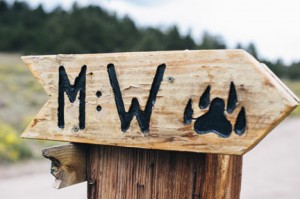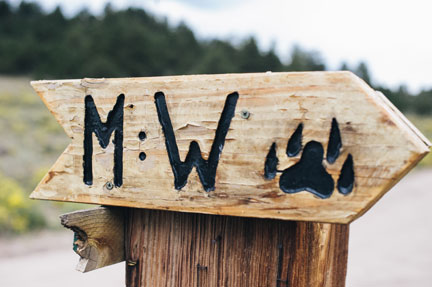By Tyler Grimes
Kent Weber enters a gate into the fenced-in home of three wolves. He makes his way down into the aspen grove where the wolves are dispersed, playfully calling them. They perk up from their food-induced stupor brought on by the 15 pounds of meat they gorged on the previous day. The wolves are drawn to Weber’s gentle authority and come to greet him. They jump up on their hind legs, place their front paws on Weber’s chest and sniff his teeth, the signature wolf greeting. He pets them like a dog, which they accept momentarily before running off.
Not far away a group of 15-plus elementary-age children and their parents eagerly wait to meet the wolves. Most of the onlookers have already toured the facility; now they await the main event. It’s Sunday evening and the end of a long week, but if there are children that want to meet the wolves, then Weber has a message to teach – a message he has devoted his life to spreading.
Mission: Wolf
Mission: Wolf is a 200-acre facility in the Wet Mountains, 40 minutes outside of Westcliffe. Weber bought the land in 1984, shortly after taking in his first wolf. “I started learning about wolves because a girl I was dating had one,” Weber said thoughtfully. “We adopted a few more and eventually I was the one taking care of them.”
Weber was an architect and an engineer before leaving his career to work with wolves full time. “It didn’t take long to see how corrupt that world was. It seemed like the more money people made, the meaner they became, so I wanted out,” recalled Weber, his gaze fixed on the hills behind his audience where the wolves hide in the foliage. “I had enough money saved that I could come out here and work for about six months. That was 26 years ago.”
Two years later, in 1988, Weber placed his land in the wolves’ name and co-founded Mission: Wolf with his partner, Tracy Brooks. “We figure if you have a wolf in a cage, it’s good for one thing:” explains Weber, “to teach people not to put wolves in cages.” Since the late ‘80s Mission: Wolf, or MW, has grown to 38 wolves and wolf-dog crosses, and thousands have had to be turned away. Despite not advertising, MW is “overwhelmed with visitors and volunteers,” according their website, www.missionwolf.com.
The wolves cautiously sniff their way toward the crowd. Weber reminds the audience, “communicate with your eyes, be confident. You’re in charge.” Weber asks one girl to remove from the group, explaining that the wolves are more likely to approach an individual first. She stands up suddenly and the wolves skittishly retreat back into their pen.
“These are ambassador wolves,” Weber explains, “so they’re actually less scared of people than most others.” MW has an Ambassador Wolf Program which goes on a 12-week bus trip around the U.S. each fall. raising awareness about wolves and allowing people to come face-to-face with wild animals. The campaign reaches nearly 30,000 people a year.
“A fourth grader put it best,” Weber says, after the wolves have made their way closer. “’I don’t remember what I hear; I believe what I see, and if I touch it I understand.’ So we want to give as many people as possible the opportunity to touch wolves.”
Wolves in the Wild
Wolves are the only animal driven to near-extinction directly by humans. Starting about 100 years ago many people, including President Teddy Roosevelt, saw wolves as pests and called for their eradication. Wolves were problematic to ranchers settling in the west because they posed a threat to their livestock. Thus, wolves were attacked and their numbers diminished.
By the 1960s there were an estimated 300 wolves in the lower 48, and they lived mostly in the northern woods of Michigan and Minnesota. In 1974 the Endangered Species Act placed the gray wolf under protection. Mexican gray wolves were saved from extinction in the 80s and red wolves survived only in captivity. “Twenty years ago there were 300 wolves in America and everyone said, ‘that’s it, they’re extinct,’” recalls Weber “They’ve grown to 4,000 in the last 15 years.” That growth has spread across 13 states in the north and west. After being protected, gray wolf populations grew and spread throughout the West.

The Endangered Species Act forced Yellowstone National Park to reintroduce wolves in 1995. The U.S. Fish and Wildlife Service was reporting then that the overall health of the park was in decline. At that time conservationists widely believed that ecosystems were built from the bottom up, with wolf health dependent on small game that ate fish and birds, which fed on small bugs and insects that relied on foliage. The result of wolf reintroduction to Yellowstone has challenged that belief.
“Trophic cascade” is the main reason that scientists believe Yellowstone is now seeing a more balanced ecosystem than it has in the last 65 years. The ecological effect shows the impact large game can have on an ecosystem. The reintroduction of wolves held elk and deer populations in check and reduced overgrazing, which diminished plant and tree health. This added mobility throughout a region, caused by hunting and running, acted as aeration to the area (similar to the lawn care technique); this created the conditions for healthier soil and grasslands.
In Yellowstone, like many places, coyote populations were nearing out-of-control levels. Wolves hunted coyotes, which limited their numbers and allowed more small rodents to thrive; this provided food for endangered eagles and osprey. Grizzly bears, also endangered, fed off of wolf kills. Bear numbers are now growing in Yellowstone. Thanks to healthier grassland and less erosion, rivers are healthier, thus fish populations are up, another source of food for bears.
According to missionwolf.com, “A wild wolf population actually makes for a stronger, healthier and more balanced ecosystem. From plant, to insect, to people …we all stand to benefit from wolves … With new knowledge of the trophic cascade, we can now begin to focus wilderness recovery efforts on a wider variety of ecosystems. Using Yellowstone as an example, we can teach the world about the wolf’s positive and vital role in the world.”
Back at Mission: Wolf, one of the more outgoing of the three wolves, Abe, approaches the crowd. First he sniffs an outlier of the group, approves, and in no time is mingling with everyone and allowing them to pet him. “Wolves just want to greet you, say hi and move on,” says Weber. “They’re not like dogs that will let you pet them all day.”
Abe was found on the streets of Salt Lake City in 2007, where he narrowly escaped being put down for being a wolf-dog. A husky shelter rescued him and brought him to MW. Abe has been an ambassador wolf for a few years and has helped raise many of the new pups brought to the rescue.
Weber answers questions, and after explaining trophic cascade, is asked why wolves aren’t reintroduced if they are good for an ecosystem. “Because politicians don’t listen to science. They listen to public opinion, which is really just marketing. Wolves are portrayed as mean and scary in the media. You’ll see a picture of a wolf yawning next to a child and the caption will read ‘Big Bad Wolf.’”
Mission: Wolf Operations
“People come here who would never talk to each other, let alone work together, let alone live together,” says Weber, “but if the wolves are first, then people’s prejudices are secondary.” Since it began, MW has been run and operated by volunteer staff that feed the wolves, give tours of the facilities and maintain the rescue. When volunteers arrive they are responsible for their own housing, and are provided food, showers and laundry. Long-term volunteers are eligible for internships that provide room and board.
Volunteers of all types, backgrounds and ages come to work with the wolves. For many, it’s a place of personal healing. One volunteer, while giving a tour of the facility, offered her perspective from volunteering over a year: “messed-up people come here and go on to live normal lives. Normal people come here and go on to do incredible things.”
“We have volunteers who come and say ‘we’re here for the rest of our lives,’ and we tell them to set up their tent and we’ll start with two weeks,” says Weber with a smirk. “Other volunteers come and eat our food and don’t work much and don’t thank us; others bring their own food, work 12-hour days and thank us when they leave.”
MW has a co-mission of sustainability. Their hope is to inspire connection between people and their earth, and create future stewards of the environment. The MW website reads, “sustainability is living within your means to have something left for tomorrow. Our modern society is afraid of what we cannot control, as demonstrated by the extermination of wild predators.”
MW is nearly completely self-sustaining. The power comes from solar panels, which store excess energy in battery banks to run through the night or on cloudy days. Wind energy is also stored in batteries. The power runs a pump that delivers water from a well. On sunny days the pump will bring up too much water, and the excess flows down through a garden.
They utilize architecture to help meet their energy needs. Greenhouses and hoop houses help extend the growing season. All the buildings on the property are built on a south-facing slope, with the north wall built into the earth and windows along the south to trap heat. Other passive solar heating techniques are in place, like size and location of doors, windows, walls and roofs and glass panels that slope upward to a structure – as the hot air rises, it heats the building.
MW is a 501(c)(3) educational nonprofit. Donated art helped pay for the land, and gift shop sales help buy fencing and material necessary to create the wolves’ habitat. Wolf sponsorship and MW membership fund food costs; other food is donated from local farmers. Donations help fill other various needs.
“Wolves and humans are similar socially,” Weber tells his students, as a second wolf, Magpie, has joined Abe in greeting their guests. “If wolves disagree with each other, they’ll snap at each other; then they feel bad, put their tails down, they’re sorry and it’s over. Sometimes wolves will fight to establish a social hierarchy within the pack. Humans could learn from wolves. If a young wolf whines they’re ignored, so they learn quickly not to whine.”
Volunteers at MW use mimicry to connect with a distressed wolf. They will copy a wolf’s every move for hours at a time, and when the wolf begins to catch on they’ll just ignore it. This grabs the wolf’s attention, and it becomes intrigued by the person. “Many of the wolves here come from traumatic backgrounds, so they have to relearn how to live in a pack,” says Weber. “We place the younger pups with some of the older ones so they can learn from them, like a mentor.”
The third wolf, Zeab, is the most bashful. He approaches people around the edges of the group but isn’t nearly as bold as Abe and Magpie. Zeab is only two years old. He came to MW from Florida when no zoo wanted to buy him. He’s lived with Abe and Magpie ever since. Any sudden movements from the kids and Zeab darts for the gate.
“Do you want to hear them howl?” asks Weber. “Alright, everyone howl.” There’s hesitation at first, but soon everyone joins in. The kids throw their heads back and howl straight toward the sky. Then the wolves join in, stretching their backs as they let out their song. The sound fills the chilly evening air, echoing off the trees and hills and settling a sense of awe over the space.
Wolves Locally
In Colorado, wolves were eradicated in the 1930s; although there have been two wolf deaths in recent years, one near Idaho Springs and another near Meeker, according to the U.S. Fish and Wildlife Service. Earlier this year, the USFWS proposed reintroducing wolves in the San Luis National Wildlife Refuge Complex to “reduce elk populations” and “improve long-term health of native plant communities.”
So would the reintroduction of wolves be good for Colorado? Most hunters and ranchers would say no. Bowsite.com, a popular hunting website, responded to the reintroduction proposal with an article titled, “Has the USFWS lost their minds?”
Weber and MW’s opinion: “Colorado is run by ranchers, miners and loggers; it has been since it became a state, and they want to keep wolves out. It shows the double-sidedness of humans. We protect animals through the Endangered Species List, but those lists are created to get the numbers high enough so we can kill them again. You’d think we would be past that, but we’re not.”
The question remains, do wolves pose a threat to the public? According to Shiloh, a volunteer at MW for the last five months, “wolves are so scared of people they will abandon their pups if a person comes across their den, and then return when the person leaves. Few animals will do that.”
A study by the Norsk Institute called “The Fear of Wolves: A Review of Wolf Attacks on Humans,” found that wolves attack humans with less frequency than any other carnivorous animal known to attack. At present there are more wolves in captivity than in the wild at roughly 250,000 to 10,000.
“I hope one day you’ll all come back here and you won’t see wolves in cages, but you’ll be able to hear them howling from the wild,” Weber says to his guests as he looks at the valley behind him, and the Sangre de Cristos beyond that. “But until then, we have to keep telling as many people as we can about the true nature of wolves.”
Tyler Grimes is looking for work in all the wrong places. Beth Johnston posted more thoughts and great photos on her site at: http://blog.yellowfeatherphotography.com/colorado-photojournalist-missionwolf/





I had a wolf/hybrid for many years. He died of cancer in 2005. He was the best “dog” and best friend I ever had.